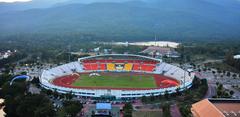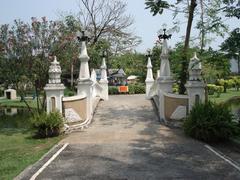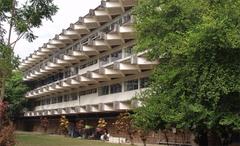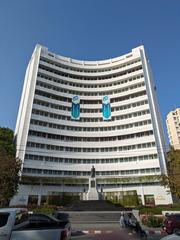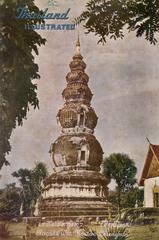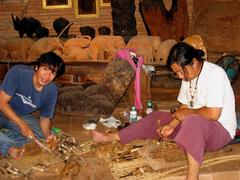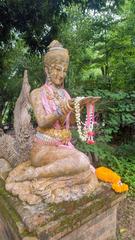Visiting Wat Suan Dok: Hours, Tickets, and Historical Sites in Mueang Chiang Mai
Publication Date: 18/07/2024
Introduction to Wat Suan Dok
Wat Suan Dok, or วัดสวนดอก, also known as Wat Buppharam, is a significant Buddhist temple nestled in the heart of Mueang Chiang Mai, Thailand. This revered site, often referred to as the “Flower Garden Temple,” dates back to the late 14th century, during the reign of King Kue Na of the Lanna Kingdom. The temple’s origins as a royal flower garden are reflected in its name and lush surroundings. Wat Suan Dok is not only a place of worship but also a center for Buddhist learning and meditation, housing the Mahachulalongkornrajavidyalaya University, which offers courses in Buddhist studies, philosophy, and Pali language (MCU Chiang Mai Campus). The temple is renowned for its architectural blend of Lanna and Sukhothai styles, featuring a grand viharn with one of Thailand’s largest bronze Buddha statues, and a serene courtyard of white chedis built to honor Chiang Mai’s royal family (Lonely Planet). This guide aims to provide a comprehensive overview of Wat Suan Dok, covering its historical significance, architectural marvels, visitor information, and preservation efforts, making it an essential read for anyone planning to explore Chiang Mai’s rich cultural heritage.
Table of Contents
- Introduction
- History and Cultural Significance
- Visiting Wat Suan Dok
- Preservation and Restoration Efforts
- Community Engagement and Social Impact
- FAQ
- Conclusion
Wat Suan Dok - A Comprehensive Guide to Chiang Mai’s Historical Flower Garden Temple
History and Cultural Significance of Wat Suan Dok
Historical Background
Wat Suan Dok, or the “Flower Garden Temple,” dates back to the late 14th century, around 1370-1371 CE, during the reign of King Kue Na of the Lanna Kingdom. Originally established as a royal flower garden, the temple’s name reflects this legacy (Tourism Authority of Thailand).
King Kue Na invited the revered monk Sumana Thera from Sukhothai to spread Buddhism in the Lanna Kingdom. Sumana Thera brought a sacred relic, believed to be a bone fragment of the Buddha, which miraculously split into two pieces. One piece was enshrined at Wat Suan Dok, while the other led to the establishment of Wat Phra That Doi Suthep (Chiang Mai Citylife).
Architectural Significance
Wat Suan Dok showcases a blend of Lanna and Sukhothai architectural styles. The temple complex includes a large viharn (assembly hall), a bot (ordination hall), and numerous chedis (stupas). The main viharn, with its high ceiling supported by massive teak pillars, houses one of Thailand’s largest bronze Buddha statues, standing at 4.7 meters (Wat Suan Dok).
The temple’s collection of white chedis, which house the ashes of Chiang Mai’s royal family, was constructed in the early 20th century by Princess Dara Rasmi to honor her ancestors. These chedis are arranged in a serene courtyard (Lonely Planet).
Cultural and Religious Significance
Wat Suan Dok is a center for Buddhist learning and meditation, home to the Mahachulalongkornrajavidyalaya University, which offers courses in Buddhist studies, philosophy, and Pali language (MCU Chiang Mai Campus). The temple plays a vital role in the annual Yi Peng and Loy Krathong festivals, celebrated with thousands of lanterns and floating offerings (Chiang Mai Best).
Visiting Wat Suan Dok
Opening Hours and Ticket Prices
Wat Suan Dok is open daily from 6:00 AM to 9:00 PM. Entry is free, but donations are welcome to support the temple’s maintenance and activities.
Travel Tips and Nearby Attractions
Located just west of the Old City, Wat Suan Dok is easily accessible by tuk-tuk or songthaew. Nearby attractions include Wat Phra Singh, Wat Chedi Luang, and the bustling Nimmanhaemin Road, known for its cafes and boutiques.
Guided Tours and Special Events
Guided tours are available and can be arranged through local tour operators or directly at the temple. Special events include meditation retreats and Dhamma talks, which are open to both locals and tourists.
Photographic Spots
Key photographic spots include the white chedis courtyard, the main viharn with its grand Buddha statue, and the temple grounds during festival times when they are adorned with lanterns.
Preservation and Restoration Efforts
Wat Suan Dok has undergone several restoration efforts, most notably under the patronage of Princess Dara Rasmi in the early 20th century. More recent projects by the Fine Arts Department of Thailand have focused on structural repairs and the restoration of intricate murals depicting scenes from the Jataka tales (UNESCO Bangkok).
Community Engagement and Social Impact
The temple hosts various programs aimed at promoting Buddhist teachings and practices, such as meditation retreats and cultural workshops. The popular “Monk Chat” program allows visitors to engage in informal conversations with monks, promoting mutual understanding and respect (Monk Chat).
FAQ
Q: What are Wat Suan Dok’s visiting hours?
A: Wat Suan Dok is open daily from 6:00 AM to 9:00 PM.
Q: Is there an entrance fee for Wat Suan Dok?
A: Entry is free, but donations are appreciated.
Q: Are there guided tours available?
A: Yes, guided tours can be arranged through local operators or at the temple.
Q: What is the best time to visit Wat Suan Dok?
A: Early morning or late afternoon are the best times to visit to avoid the midday heat and crowds.
Conclusion
Wat Suan Dok stands as a testament to the rich cultural and religious heritage of Chiang Mai. Its historical significance, architectural beauty, and role in the community make it a must-visit destination for anyone exploring Northern Thailand. Through ongoing preservation efforts and community engagement, Wat Suan Dok continues to be a beacon of Buddhist tradition and a source of inspiration for future generations.
